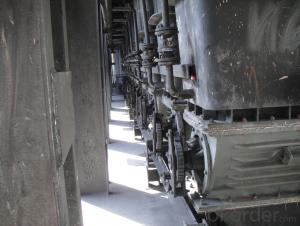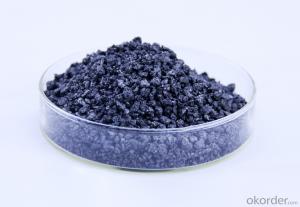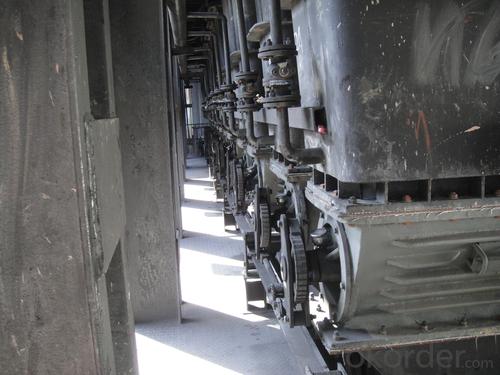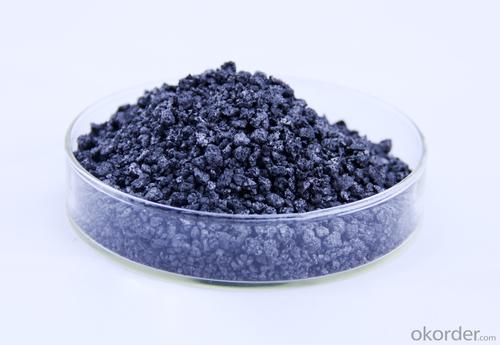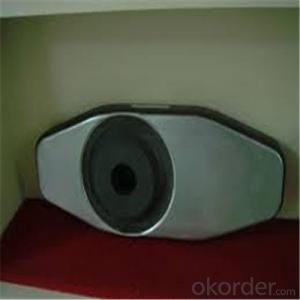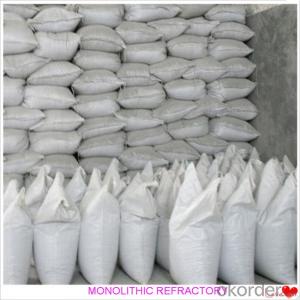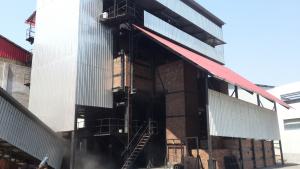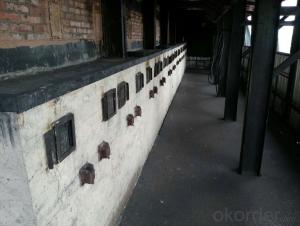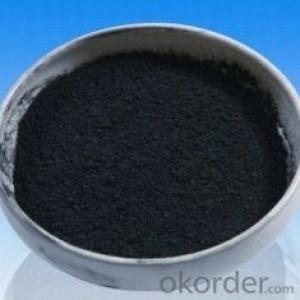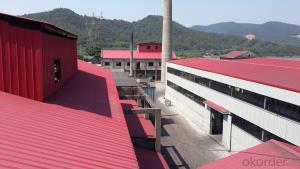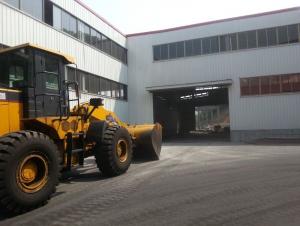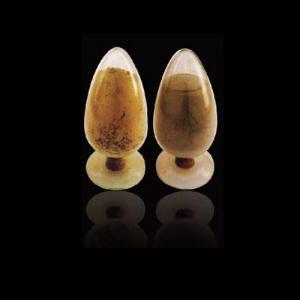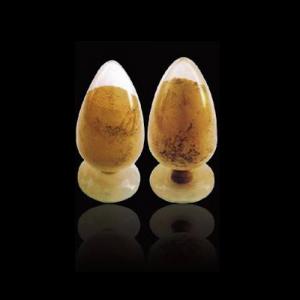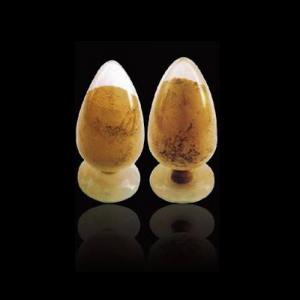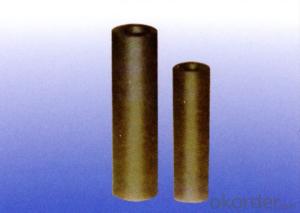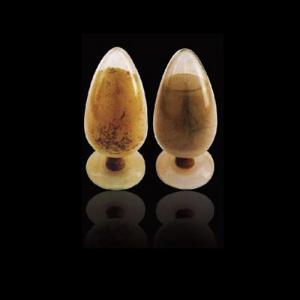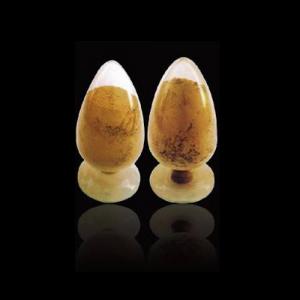Monolithic Refractories for Iron and Steel Industry - Pitch Coke Coaly as Carbon Raiser and Carbon Additive
- Loading Port:
- Shekou
- Payment Terms:
- TT OR LC
- Min Order Qty:
- 20 m.t
- Supply Capability:
- 1000 m.t/month
OKorder Service Pledge
OKorder Financial Service
You Might Also Like
Factory Background
The factory is majorly running and operating carbon additive (pitch coke, calcined petroleum coke and anthracite), low nitrogen carbon additive, and brake pad making material. Company is the long term supplier of Sinosteel Corporation, Shanghai Carbon Corporation, the plant of SGL Group the Carbon Company in China and some largest special carbon products producing plants.
YUAI also supplies huge amout of high quality carbon additive and graphite carbon additive to steel plants, foundries and ferrotungsten plants. YUAI has been assigned by BAO STEEL as the only organization for processing pitch coke for export purpose. The group’s major products are constantly exported to Japan, Korea, Malaysia, South East Asia countries, Europe and America, which receive praises by our consumers.
The group has invested numbers of calcinators in Anhui China to ensure the capability of producing and processing huge amount of carbon additive. Further investment is on process. According to the orders from customers, YUAI is able to processing and providing different specifications of carbon additive and other products. To provide best quality of products and to offer customers most satisfied service is YUAI’s operating objectives.
Calcined Petroleum Coke
FC:98.5%min,
S:0.5%max
A:0.8%max
V:0.7%max
Mositure:0.5%max
Size:1-5mm
This product is mainly used in steel-making and foundry. Calcined Petroleum Coke
Calcined Petroleum Coke comes from delayed coke which extracted from oil refinery. Although Calcined Petroleum Coke contains a little bit higher level of sulfur and nitrogen than pitch coke, the price advantage still makes it widely used during steel-making and founding as a kind of carbon additive/carburant.
Technology:
Laborary Equpment
In our lab,we has a high precision balance,mullfe furnace,sample making machine, dring box,sulfur measurement instrument and other calibratiing equipments.As a result,before deliverung to our customers,our products have to pass a strict test to ensure the quality and components.The testing reports will be sent to our customers to confirm untill they satisfy with it.
Packaging & Delivery
Packaging Detail:25kg paper bag into 1t weaving bag 5kg, 10kg and 20kg weaving bag into 1t weaving bag 25kg weaving bag put on pallet covered with entanglement wrap product direct into packing bag 25kg paper bag put on pallet covered with entanglement Wrap 25kg weaving bag into 1t weaving bag.
Delivery Details: 7 days
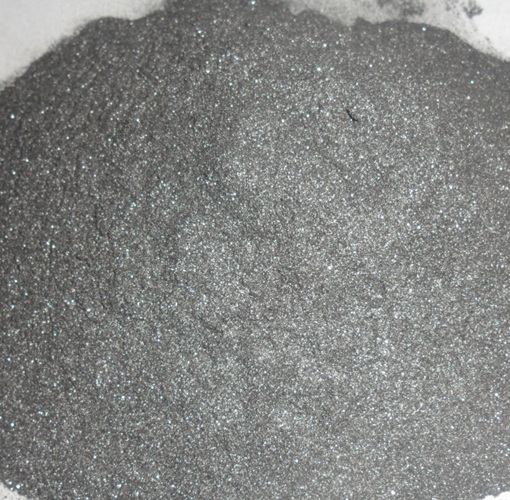
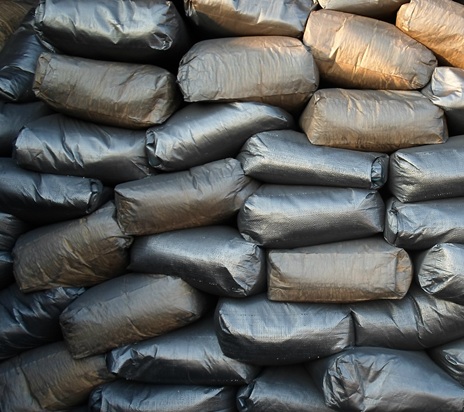
- Q: How do monolithic refractories help in enhancing the durability of iron and steel furnaces?
- Monolithic refractories play a crucial role in enhancing the durability of iron and steel furnaces due to their unique properties and characteristics. These materials are designed to withstand extremely high temperatures and harsh conditions, making them ideal for lining the furnaces. Firstly, monolithic refractories have excellent thermal resistance, meaning they can withstand extreme heat without losing their structural integrity. Iron and steel furnaces operate at incredibly high temperatures, sometimes exceeding 2,000 degrees Celsius. Regular bricks or other materials would not be able to withstand such temperatures, leading to frequent repairs and maintenance. Monolithic refractories, on the other hand, can handle these extreme temperatures without deteriorating, thus enhancing the durability of the furnaces. Secondly, monolithic refractories have high resistance to chemical attack. In iron and steel production, the materials being processed often contain various impurities and aggressive chemicals. These substances can react with the furnace lining and cause corrosion or erosion over time. However, monolithic refractories have a high resistance to chemical attack, ensuring that the lining remains intact and durable even in the presence of corrosive elements. Furthermore, monolithic refractories have excellent mechanical strength and abrasion resistance. Iron and steel furnaces experience mechanical stress and abrasion due to the movement of raw materials, the stirring of molten metal, and the tapping of the furnace. The lining needs to withstand this constant wear and tear without breaking or cracking. Monolithic refractories have superior mechanical strength and can resist abrasion, ensuring that the furnace remains durable and functional for a longer period. Additionally, monolithic refractories offer exceptional thermal shock resistance. The lining of iron and steel furnaces is subjected to rapid temperature changes during various stages of production. These temperature fluctuations can cause thermal stress and lead to cracking or spalling of the lining. However, monolithic refractories have low thermal conductivity and can withstand thermal shock, preventing any damage to the furnace lining and enhancing its durability. In summary, monolithic refractories help enhance the durability of iron and steel furnaces by providing excellent thermal resistance, high resistance to chemical attack, superior mechanical strength and abrasion resistance, as well as exceptional thermal shock resistance. These properties ensure that the furnace lining remains intact, withstands extreme temperatures, and resists the corrosive and abrasive nature of the materials being processed, ultimately prolonging the life of the furnace and reducing the need for frequent repairs or replacements.
- Q: How do monolithic refractories resist high temperatures?
- Monolithic refractories are designed to resist high temperatures due to their unique composition and structure. These refractories are made from a single piece or material, unlike traditional refractory bricks that are composed of multiple pieces. The main reason why monolithic refractories can resist high temperatures is their high melting point. These refractories are made from materials such as alumina, silica, and magnesia, which have high melting points ranging from 1650°C to 2000°C. This means that they can withstand extreme temperatures without undergoing significant deformation or melting. Furthermore, monolithic refractories possess excellent thermal stability. They have low thermal conductivity, which means they can effectively insulate against heat transfer. This property allows the refractories to maintain their structural integrity even when exposed to rapid temperature changes or thermal shocks. In addition, the monolithic nature of these refractories provides them with enhanced resistance to thermal stress. Unlike traditional refractory bricks, monolithic refractories do not have joints or seams that can be vulnerable to thermal expansion and contraction. This makes them more resistant to cracking or spalling when subjected to high temperatures. Moreover, monolithic refractories can form a protective layer or slag on their surface when exposed to high temperatures. This slag acts as a barrier and prevents direct contact between the refractory material and the hot gases or molten metals, reducing the risk of chemical reactions or corrosion. Overall, the combination of high melting point, thermal stability, resistance to thermal stress, and the ability to form protective slag makes monolithic refractories highly effective in resisting high temperatures. They are widely used in various industries, including steel, cement, glass, and petrochemical, where they are exposed to extreme heat conditions.
- Q: How do monolithic refractories withstand thermal shock and mechanical stress?
- Monolithic refractories are designed to withstand thermal shock and mechanical stress due to their unique composition and installation process. These refractories are made from a single, continuous material, eliminating any joints or seams that could weaken the structure. Additionally, they have a high thermal conductivity which allows them to efficiently distribute and dissipate heat, minimizing thermal gradients that can cause cracking. Furthermore, the installation technique involves forming the refractory in situ, ensuring a tight fit and reducing the likelihood of mechanical failure. Overall, the combination of their composition, thermal conductivity, and installation method enables monolithic refractories to withstand thermal shock and mechanical stress effectively.
- Q: How are monolithic refractories used in the iron and steel industry?
- Monolithic refractories are extensively used in the iron and steel industry for various applications due to their superior performance and versatility. These refractories are composed of a single, uniform material and are designed to be used as a seamless lining in high-temperature environments. In the iron and steel industry, monolithic refractories play a crucial role in different stages of the manufacturing process. One of the primary applications is in the blast furnace, where monolithic refractories are used to line the inside of the furnace. This lining is subjected to extremely high temperatures and harsh chemical reactions. Monolithic refractories provide excellent thermal insulation and resistance to chemical attack, ensuring the structural integrity and longevity of the blast furnace. Another important application is in the steelmaking process. Monolithic refractories are used to line the ladles and tundish, which are used to transport and pour molten steel. These refractories are specially designed to withstand the high temperatures and corrosive nature of the molten steel, preventing contamination and ensuring the quality of the final product. Moreover, monolithic refractories are also used in various ancillary equipment and structures in the iron and steel industry. They are employed in furnaces, kilns, and other heat treatment systems to provide insulation and maintain high-temperature conditions. Additionally, monolithic refractories are used in the construction of chimneys, exhaust ducts, and other exhaust systems, where they provide thermal insulation and resistance to corrosive gases. Overall, monolithic refractories play a vital role in the iron and steel industry by providing high-temperature insulation, chemical resistance, and durability. They help optimize the production process, improve energy efficiency, and ensure the quality of the final product. With their versatility and excellent performance, monolithic refractories have become an indispensable component in the iron and steel manufacturing industry.
- Q: How do monolithic refractories resist chemical attacks from molten metals and slag?
- Monolithic refractories are engineered to withstand chemical attacks caused by molten metals and slag. They possess various essential qualities that enable them to endure such harsh conditions. To begin with, monolithic refractories comprise top-notch materials with exceptional chemical resistance. These materials, including alumina, magnesia, and chrome, have a high melting point and remain stable even when exposed to extreme temperatures and corrosive substances. This chemical stability ensures that the refractory maintains its integrity and structural strength when in contact with molten metals and slag. Moreover, monolithic refractories have a compact and dense structure. This microstructure serves as a barrier, preventing molten metals and slag from penetrating the refractory material. By limiting the contact between the corrosive substances and the refractory, the dense structure reduces the likelihood of chemical reactions and erosion, thereby enhancing the refractory's resistance to chemical attacks. Additionally, monolithic refractories often contain additives and binders that enhance their chemical resistance. These additives form a protective layer on the refractory surface, acting as a shield against chemical attacks. They can also react with certain corrosive substances, forming stable compounds that further inhibit the penetration and corrosion of the refractory material. Furthermore, monolithic refractories are designed to have minimal porosity. This low porosity minimizes the absorption of molten metals and slag, preventing them from infiltrating the refractory and causing damage. By reducing the permeability of the material, the refractory can maintain its structural integrity and resist chemical attacks for extended periods. In conclusion, monolithic refractories withstand chemical attacks from molten metals and slag due to their high-quality materials, dense structure, additives, and low porosity. These combined properties enable the refractories to endure aggressive environments and maintain their performance and longevity in industrial applications.
- Q: How do monolithic refractories enhance the performance of ladle and tundish covers?
- The performance of ladle and tundish covers is significantly improved by the utilization of monolithic refractories. There are several ways in which this enhancement is achieved. Primarily, monolithic refractories possess remarkable thermal insulation properties. The steelmaking process subjects ladles and tundishes to extreme temperatures. Through the use of monolithic refractories, the covers effectively trap and retain heat, preventing excessive heat loss. This insulation ability not only helps maintain the desired temperature of the molten steel but also reduces the energy consumption required for heating. Secondly, monolithic refractories demonstrate exceptional resistance to thermal shock. When ladles and tundishes are filled with molten steel, there is a rapid and drastic temperature change in the refractory lining. This sudden shift can cause cracking and spalling of the lining, jeopardizing its integrity. However, monolithic refractories possess high thermal shock resistance, enabling them to endure these abrupt temperature fluctuations without significant damage. This ensures the longevity and durability of the ladle and tundish covers. Additionally, monolithic refractories exhibit excellent corrosion resistance. The presence of molten steel and other corrosive substances in ladles and tundishes can erode the refractory lining over time. Nonetheless, monolithic refractories are specifically engineered to withstand these corrosive environments, shielding the covers from chemical attack and erosion. This corrosion resistance enhances the lifespan of the ladle and tundish covers, reducing the need for frequent replacements and associated downtime. Furthermore, monolithic refractories provide good mechanical strength and stability. Ladles and tundishes undergo various mechanical stresses, including the weight of the molten steel, thermal expansions, and vibrations. The use of monolithic refractories furnishes the necessary strength and stability to endure these mechanical forces, averting structural failures and maintaining the integrity of the covers. To summarize, monolithic refractories heighten the performance of ladle and tundish covers by providing exceptional thermal insulation, resistance to thermal shock and corrosion, and sufficient mechanical strength. These properties guarantee efficient steelmaking processes, diminish maintenance costs, and extend the lifespan of ladles and tundishes.
- Q: What are monolithic refractories and how are they different from other refractory materials?
- Monolithic refractories, unlike bricks or tiles, are refractory materials that are not pre-formed into specific shapes or sizes. Instead, they are composed of a mixture of aggregates, binders, and additives, which are then installed and cured to create a solid and dense structure. One notable difference between monolithic refractories and other refractory materials is their versatility and ease of installation. While traditional bricks or tiles require skilled labor and careful assembly, monolithic refractories can be poured, sprayed, or gunned into place, allowing for a faster and more efficient installation process. This makes them particularly suitable for complex shapes or hard-to-reach areas. Another distinction lies in the physical properties of monolithic refractories. Unlike bricks and tiles, which are known for their mechanical strength and resistance to thermal shock, monolithic refractories can be customized to exhibit a wide range of properties. Depending on the specific application requirements, they can be engineered to have excellent thermal insulation, superior corrosion resistance, or enhanced abrasion resistance. This adaptability makes monolithic refractories suitable for various industries, including steel, cement, glass, and petrochemical. Furthermore, monolithic refractories have the advantage of being able to expand and contract with temperature changes, unlike rigid brick structures. This thermal flexibility helps prevent cracking and damage caused by thermal cycling, thus prolonging the lifespan of the refractory lining. Additionally, monolithic refractories offer better refractory integrity and reduced joint failure since they do not have seams or weak points that are susceptible to thermal stresses. In conclusion, monolithic refractories are a versatile and convenient type of refractory material that can be tailored to meet specific application requirements. Their easy installation, thermal flexibility, and customizable properties distinguish them from other refractory materials like bricks or tiles.
- Q: How are monolithic refractories different from conventional refractories?
- There are several ways in which monolithic refractories differ from conventional refractories. To begin with, conventional refractories are typically constructed using pre-formed shapes like bricks or tiles, whereas monolithic refractories are shapeless and can be installed through casting, gunning, or ramming. This allows for greater design and installation flexibility since monolithic refractories can be molded to fit any complex shape or size requirement. Additionally, monolithic refractories possess a higher level of thermal shock resistance compared to conventional refractories. This means that they can withstand rapid temperature changes without cracking or spalling. This characteristic is especially significant in applications where the refractory is exposed to extreme temperature fluctuations, such as in furnaces or kilns. Moreover, monolithic refractories exhibit superior corrosion resistance, making them more suitable for environments with acidic or alkaline conditions. They are also renowned for their exceptional mechanical strength and resistance to abrasion, making them ideal for situations where the refractory experiences high mechanical stress or wear. Lastly, monolithic refractories offer enhanced energy efficiency due to their lower thermal conductivity. Consequently, they can retain heat more effectively, resulting in reduced energy consumption and cost savings. In summary, the key distinctions between monolithic refractories and conventional refractories lie in their installation methods, thermal shock resistance, corrosion resistance, mechanical strength, and energy efficiency. These factors establish monolithic refractories as the preferred choice in numerous industrial applications where flexibility, durability, and performance are of utmost importance.
- Q: What are the key factors to consider when designing the lining system with monolithic refractories?
- When designing a lining system with monolithic refractories, there are several key factors that need to be considered. Firstly, the operating conditions of the system need to be thoroughly assessed. Factors such as temperature, pressure, and chemical composition of the materials being processed should be taken into account. This will help determine the appropriate type of monolithic refractories to be used. Secondly, the physical and mechanical properties of the refractories should be considered. These include factors like thermal conductivity, thermal expansion, and mechanical strength. The refractories should have properties that are compatible with the specific requirements of the system to ensure optimal performance and longevity. Thirdly, the installation method and techniques need to be carefully planned. The lining system should be designed in a way that allows for proper installation and ensures a tight seal to prevent any leakage or infiltration. The installation process should also take into account factors like curing time and temperature to ensure the refractories achieve their desired properties. Lastly, the cost and availability of the refractories should be considered. It is important to choose refractories that are cost-effective and readily available in the market. This will help ensure that any maintenance or repairs can be done efficiently without causing significant downtime or additional expenses. By considering these key factors, a well-designed lining system with monolithic refractories can be implemented, providing optimal performance, durability, and cost-effectiveness for the specific application.
- Q: How do monolithic refractories contribute to reducing downtime in iron and steel plants?
- Monolithic refractories play a crucial role in reducing downtime in iron and steel plants by offering several key advantages over traditional brick refractories. Firstly, monolithic refractories are highly versatile and can be easily molded and installed, allowing for quicker repairs and replacements. Unlike brick refractories that require time-consuming and labor-intensive processes, such as bricklaying and mortar application, monolithic materials can be directly applied in a castable or gunning form, significantly reducing the downtime required for repairs. Additionally, monolithic refractories provide better thermal insulation and improved resistance to thermal shocks, which are common occurrences in iron and steel plants. This enhanced thermal performance helps to maintain stable operating temperatures and prevents sudden temperature fluctuations that can lead to refractory failure and subsequent downtime. By minimizing these thermal shocks, monolithic refractories increase the overall lifespan of the refractory lining, reducing the need for frequent repairs and replacements. Furthermore, monolithic refractories offer superior chemical resistance compared to traditional brick refractories. Iron and steel plants often encounter aggressive chemical environments due to the presence of molten metal, slag, and other corrosive substances. Monolithic refractories are specifically designed to withstand these harsh conditions, preventing chemical attacks and erosion of the refractory lining. As a result, the need for unscheduled shutdowns due to refractory degradation is significantly reduced. Lastly, monolithic refractories provide better dimensional stability, minimizing the risk of cracks and spalling that can occur due to thermal cycling and mechanical stress. This increased resistance to wear and tear ensures that the refractory lining remains intact for a longer period, reducing the frequency of maintenance and enhancing the overall operational efficiency of the iron and steel plant. In summary, monolithic refractories contribute to reducing downtime in iron and steel plants by offering faster installation, improved thermal insulation, superior chemical resistance, and enhanced dimensional stability. Their versatility and performance advantages make them a reliable choice for maintaining a reliable and efficient refractory lining, ultimately reducing the frequency and duration of plant shutdowns.
Send your message to us
Monolithic Refractories for Iron and Steel Industry - Pitch Coke Coaly as Carbon Raiser and Carbon Additive
- Loading Port:
- Shekou
- Payment Terms:
- TT OR LC
- Min Order Qty:
- 20 m.t
- Supply Capability:
- 1000 m.t/month
OKorder Service Pledge
OKorder Financial Service
Similar products
Hot products
Hot Searches
Related keywords
